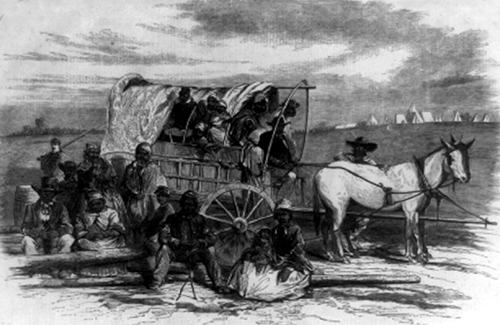
Fugitive African Americans Fording the Rappahannock River. Rappahannock, Virginia, August 1862.
Photographed by Timothy H. O'Sullivan, this is an image of African Americans seeking to gain freedom behind Union lines. It was taken in the main eastern theater of the war during the second battle of Bull Run in 1862.

According to the North Carolina History Project: Before the end of the Civil War, as Union troops occupied more and more of North Carolina during the Civil War, more and more slaves fled to Union lines to live in what were then called contraband camps. Contrabands were escaped slaves from the Confederate territory into Union territory. By late 1861, Union generals in North Carolina refused to return contrabands to their owners, so that the Confederacy might be deprived of its slave labor. Contraband camps were located on the outskirts of Union encampments and provided a haven for escaped slaves.

In the illustration above, Union troops distribute clothes to a contraband camp in New Bern, NC. Image courtesy of the North Carolina Office of Archives and History, Raleigh, NC.
In the camps, contrabands worked for wages; however, they were not always paid in cash. The deduction of food and clothing lowered their wages. Despite the loss in wages, contrabands received formal education previously denied in the past. Northern missionaries from the American Missionary Association and the New York branch of the National Freedmen’s Relief Association, for example, started schools for escaped slaves. Contrabands also started and maintained their own schools and churches. As noted by historian Patricia Click, once Union forces gained control over several areas in coastal North Carolina, escaped slaves fled into the occupied territory. By the midsummer of 1862, over 10,000 contrabands were living in Union-occupied areas.

In April 1863, Major General John G. Foster appointed Horace James, an evangelical Congregationalist minister and abolitionist from Worcester, Massachusetts, as the superintendent of Negro Affairs. James supervised contraband camps at Beaufort, New Bern, Plymouth, Roanoke Island, and Washington. The number nearly doubled by January 1864, with 17,419 contrabands living within Union lines. In North Carolina, contraband camps varied in size. Out of the six camps, New Bern became the largest with 8,591 contrabands. The rest contained a total of 8,801: 2,426, in Beaufort, 89 in Hatteras, 860 in Plymouth, 2,712 in Roanoke Island, and 2,714 in Washington.
Three of the six camps were destroyed by Confederate attack. Only Beaufort, New Bern, and Roanoke Island survived. (source: North Carolina History Project)
Ron... I shouldn't be surprised to end up here. Researching my gr gr grandparents migration from North Carolina to Massachusetts, I couldn't figure out how a family that couldn't read or write and had no money could migrate 600miles through a war zone. They didn't appear in the North Carolina Negro Cohabitation Record of 1866, which means they had probably already left NC. But they appear in the 1970 Census in Cambridge MA.
ReplyDeleteThere are also a lot of other Blacks in that Census from NC with surnames still found in Chowan and Perquimans counties. I suspect the found their way to a contraband camp and of maybe was in contact with some missionary from Worcester MA.
Hey Ripama:
ReplyDeleteHappy Thanksgiving!
It's amazing to unearth the historic migrations. The former slaves of the USA were some of the most resilient and resourceful people. They were able to create a way out of noway; craft something our of nothing.
It humbles me to read and research their stories. Truth is far more fascinating than fiction.
Enjoy your holiday!
--Ron
Thanks...And to you and yours as well.
ReplyDelete